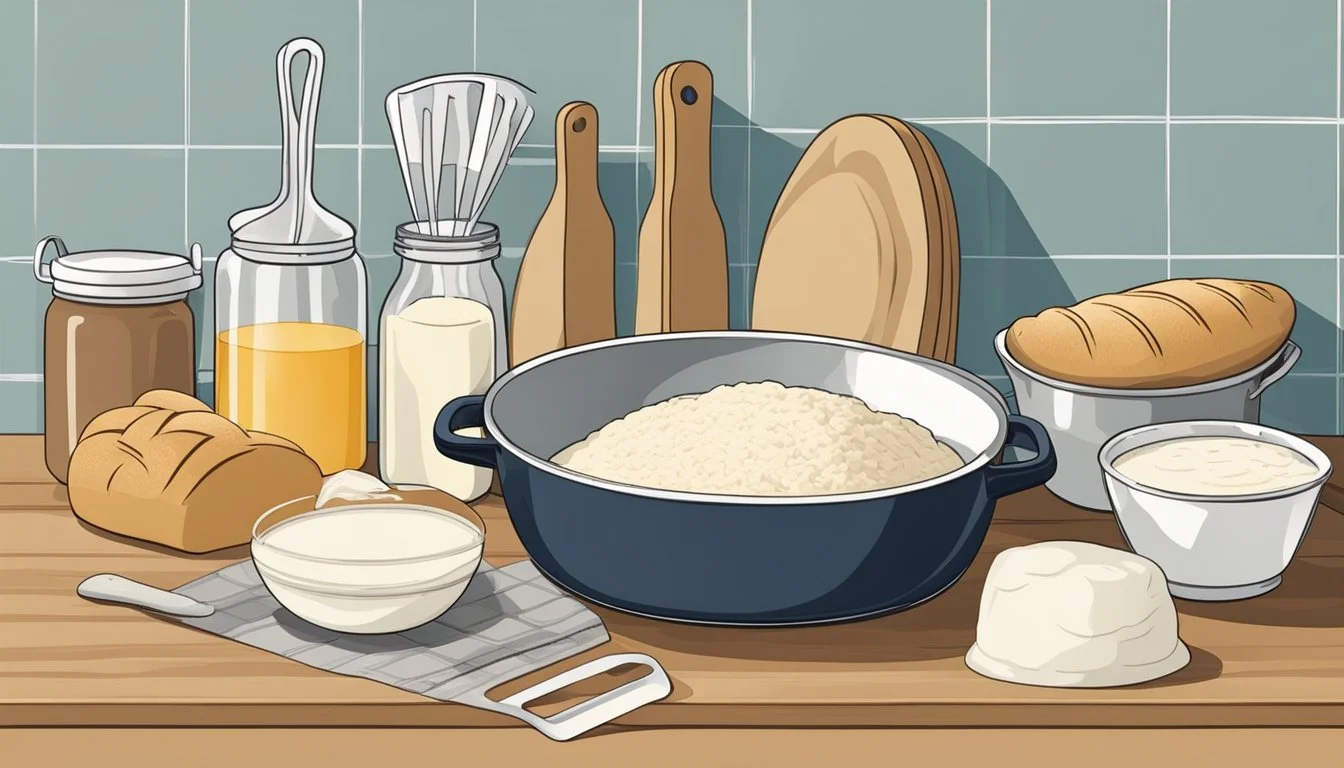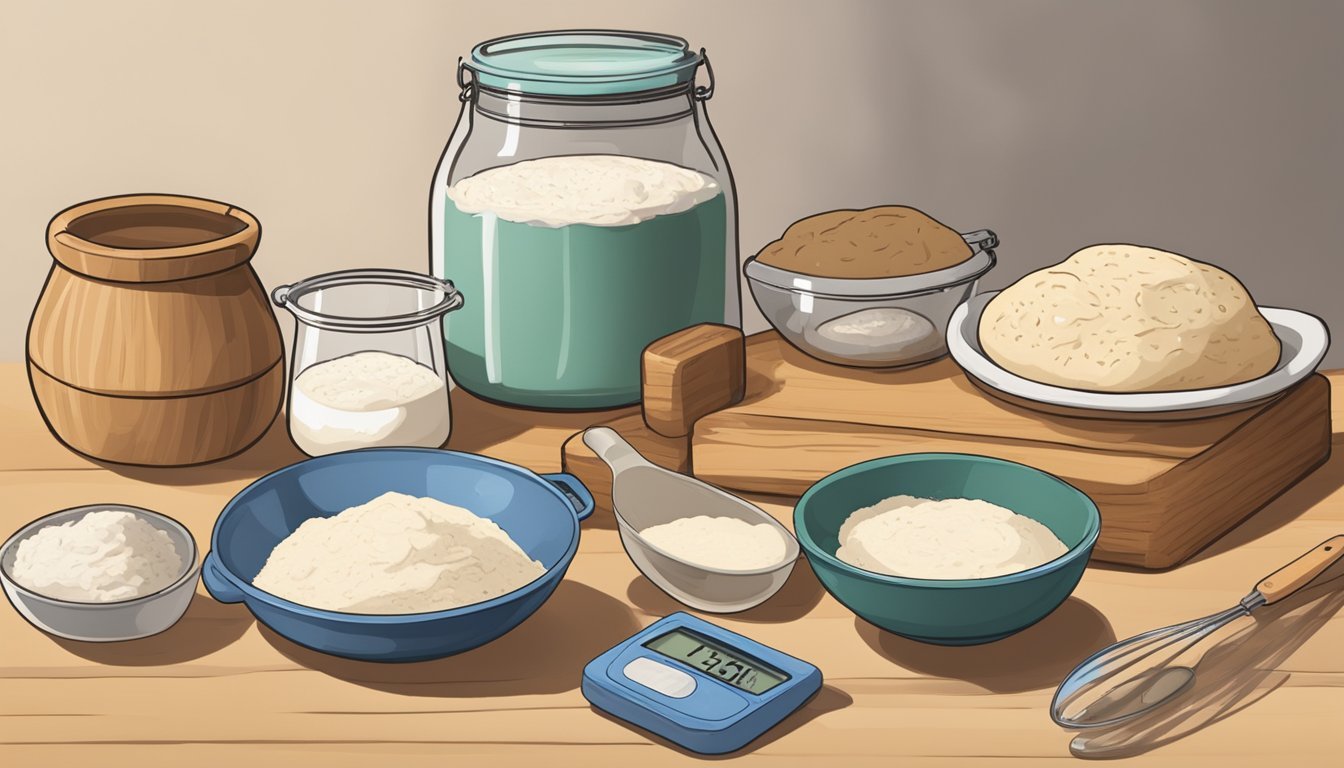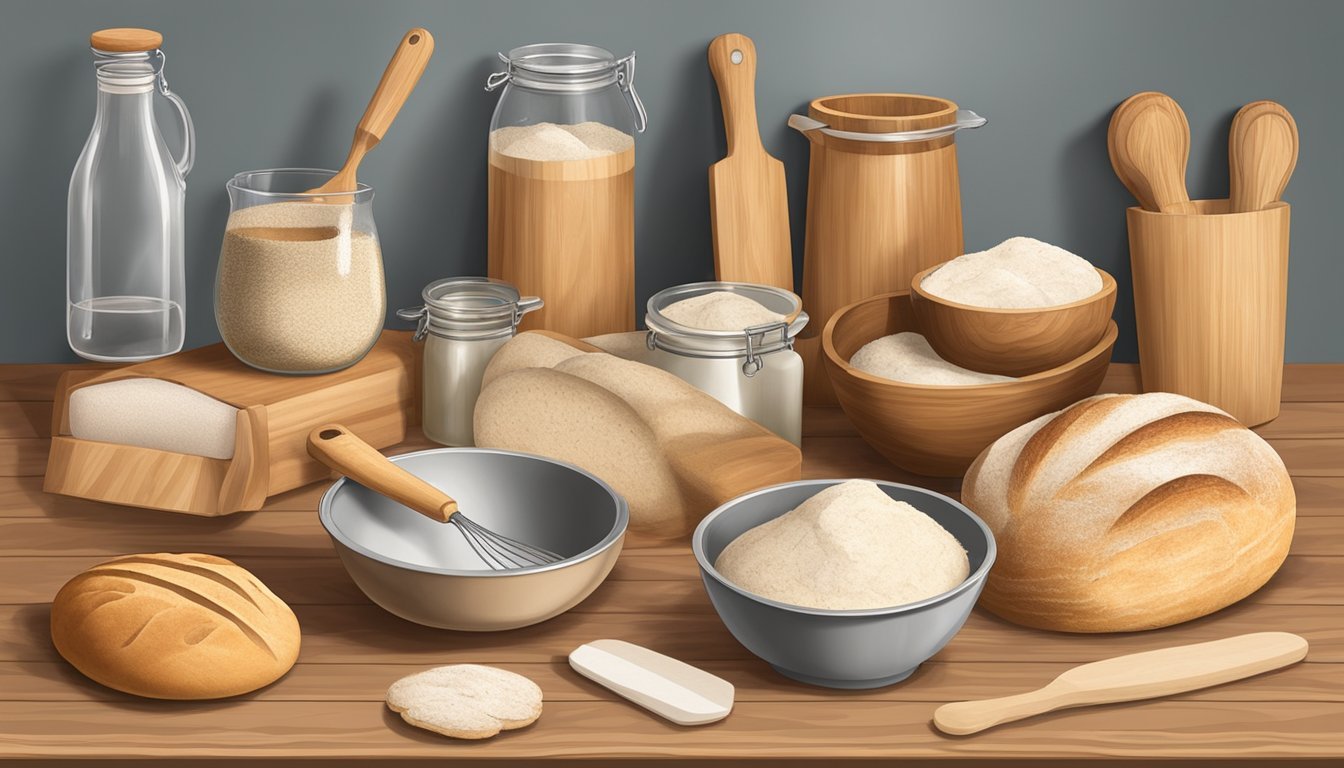Top 10 Sourdough Bread Baking Tools Every Baker Needs
Essential Gear for Perfect Loaves
Sourdough bread (What wine goes well with bread?) baking is an art that combines simplicity and complexity. With just flour, water, and salt, bakers can create a wide array of sourdough loaves, each with its own unique flavor, crumb, and crust. However, the process of making sourdough is delicate and requires precision. It is about understanding the nuances of fermentation, dough handling, and baking. Bakers rely on specific tools designed to aid in every step of the sourdough making process, enhancing both the experience and the final product.
To achieve consistent results and to handle the dough with care, there is a set of tools considered essential in the sourdough baker's kitchen. A digital scale facilitates accurate measurements, ensuring the correct ratio of ingredients. Tools like bread lames and dough scrapers not only assist in shaping loaves but also contribute to the final appearance and structure of the bread. Utilizing the right equipment not only makes the process smoother but can also elevate the quality of the sourdough bread.
Moreover, maintaining the starter culture—the heart of sourdough bread—is a crucial part of the process that should not be overlooked. A healthy starter is the lifeblood of sourdough, and bakers often use glass jars for storing their starters, which allows for easy monitoring of the fermentation activity. Each baker may find different tools indispensable based on their own techniques and preferences, yet there is a core toolkit that unites all who pursue the craft of sourdough bread baking.
Essential Sourdough Baking Concepts
When embarking on sourdough baking, understanding the cornerstones of the craft is crucial. Here's a breakdown of the fundamental concepts:
Sourdough Starter: This is a live culture of flour and water that captures wild yeast and bacteria. Maintaining a vibrant starter is the soul of sourdough bread, as it enables the dough to rise without commercial yeast. The starter should be fed regularly, and its health is reflected in the bread's flavor and texture.
Ingredients: The purity and quality of ingredients impact not only the nutrition but also the flavor of the bread. Common sourdough ingredients include:
Flour: Whole grain flours offer more nutrients and complex flavors.
Water: Temperature and quality of water can affect dough consistency.
Salt: Regulates fermentation and enhances taste.
Recipe and Technique: Each sourdough bread recipe directs the ratios and procedures to create distinct textures and flavors. Mastering techniques like kneading, shaping, and scoring is as critical as the recipe itself.
Fermentation: Sourdough relies on the natural fermentation process. Fermentation is affected by factors such as:
Temperature: A warm environment speeds up fermentation.
Time: Longer fermentation adds complexity to the bread’s flavor.
Hydration: The ratio of water to flour affects the fermentation rate and dough structure.
By grasping these essential baking concepts, bakers become equipped to produce sourdough bread with desirable characteristics: a crispy crust, a chewy interior, and a rich flavor profile.
Key Tools for Mixing and Fermentation
Proper tools for mixing and fermentation are crucial for every sourdough baker. They ensure precision and consistency, which are key to successful sourdough bread making. Here we highlight the essential tools required during the initial steps of sourdough preparation.
Mixing Bowls
A variety of mixing bowls are essential in any baker's kitchen. For sourdough bread, bakers should have at least one large bowl. This bowl needs to accommodate the dough's rising during bulk fermentation without spilling over. Stainless steel or glass bowls are preferred due to their non-reactive nature.
Digital Scale
Kitchen scales are indispensable for measuring ingredients accurately, especially for sourdough where the ratio of flour to water can greatly affect the outcome. Bakers should use a digital scale capable of measuring to the nearest gram, ensuring precision in ingredient proportions.
Dough Whisk
A dough whisk is specifically designed to combine wet and dry ingredients with ease. Its structure is made to cut through thick dough without overworking it, which is a common concern during hand mixing. This tool reduces the effort required to integrate the starter with the flour and water effectively.
Fermentation Containers
Fermentation containers are used to provide sourdough starter with a consistent environment to grow. Clear containers are preferred as they allow the baker to observe the starter's growth. They often are marked with a rubber band to note the starter's initial level, making it easy to monitor the rise. Common choices include glass Weck jars or plastic containers with plastic lids that allow gases to escape without letting in contaminants.
Shaping the Perfect Sourdough Loaf
Shaping sourdough is a crucial step in bread baking as it ensures a uniform structure and affects the final bake. Mastery of shaping tools can greatly enhance the quality of the final loaf, giving it an artisanal touch.
Bench Scraper
A bench scraper is indispensable for dividing dough and transferring it without sticking. They employ a sturdy straight edge for cutting dough cleanly and can also assist in shaping by providing a physical guide to fold against.
Banneton Baskets
Banneton baskets are traditionally used to hold the shaped bread as it proofs. They are typically lined with rice flour to prevent sticking, imparting a beautiful spiral pattern on boules. For a standard sourdough loaf, a round banneton works best.
Proofing Baskets
Similar to bannetons, proofing baskets support the dough's shape and allow for consistent rising. they come in various shapes, enabling bakers to craft not only boules but also batards and baguettes. They can also be lined or unlined, with the choice of lining altering the dough's surface texture.
Scoring Tools
A proper bread lame or scoring tool is essential for scoring or slashing the top of the dough right before baking. This allows the bread to expand predictably during the baking process and prevents random splits. A sharp lame ensures clean cuts for a professional look.
Using the right tools during the shaping phase can make a significant difference in appearance and quality of sourdough bread. Bakers should consider these tools vital components of their baking repertoire.
Mastering the Baking Process
Mastering sourdough baking requires precision from preparation to storage. Each stage in the baking process plays a crucial role in achieving the perfect loaf.
Oven Preparation Tools
To ensure consistent heat throughout the baking process, bakers should preheat their ovens with precision. Parchment paper is also essential for transferring the dough without sticking, and it simplifies cleanup. A baking stone or steel can provide a stable, high-heat surface for the bread to bake evenly.
Parchment Paper: for easy dough transfer
Baking Stone/Steel: for even heat distribution
Baking Vessels
A Dutch oven or combo cooker is highly recommended for home bakers since they mimic professional ovens by trapping steam. This steam is critical for achieving a well-developed crust and maximizing oven spring. Cast iron vessels are preferred for their superb heat retention.
Baking Vessel Options:
Cast Iron Dutch Oven: Excellent for heat retention and steam trapping
Combo Cooker: Versatile for both baking and other cooking needs
Cooling and Storage
After baking, the bread needs to be cooled properly to complete the cooking process and develop flavor. A cooling rack allows air to circulate and prevents condensation from making the crust soggy. For storage, keep sourdough bread in a bread box or paper bag to maintain freshness.
Cooling Rack: Ensures proper air circulation
Bread Box/Paper Bag: Preserves freshness and crust quality
Advanced Sourdough Bread Tools
In this section, professional bakers will discover tools that elevate the art of sourdough bread baking. These advanced instruments cater to specific techniques offering precision and consistency in the baking process.
Specialized Knives and Blades
A bread lame, or razor blade, is indispensable for scoring dough, a step that directs the bread's expansion and contributes to the visual appeal and structure of the final product. High-quality lames offer a secure grip and interchangeable blades that ensure sharpness for clean cuts.
Bread Knife: A sharp bread knife is crucial for slicing through crusty sourdough without crushing the soft interior.
Razor Blade: Reserved for slashing the dough; a double-sided razor attached to a handle provides precise control and depth.
Precision Baking Instruments
Accuracy is key to consistent results in sourdough baking. A precision digital scale can measure flour, water, salt, and yeast with exactitude, ensuring that every batch follows the recipe perfectly.
Instant-Read Thermometer: This tool checks the dough's temperature during fermentation and the bread's internal temperature post-baking.
Baking Scale: A high-capacity scale with 1-gram increments allows bakers to replicate recipes accurately.
Alternative Baking Surfaces
Baking surfaces significantly impact the texture and crust of sourdough loaves. Options such as a baking stone or baking steel emulate the conditions of professional ovens, creating superior oven spring and crust.
Baking Stone: It provides a consistent, absorbent heat source, ideal for a thick, artisanal crust.
Baking Steel: A more recent innovation that retains and transfers heat more efficiently than stone, yielding a great rise and crispier crust.
Utility and Maintenance Tools
Proper utility and maintenance tools are indispensable for the consistency and longevity of the bread-baking process. They ensure cleanliness and convenience which are paramount in sourdough bread-making.
Cleaning Accessories
Bench Scrapers and Bowl Scrapers: These tools are essential for keeping work surfaces and mixing bowls clean. A metal bench scraper is perfect for dividing dough and scraping work surfaces, while a flexible plastic bowl scraper can easily remove sticky dough remnants from bowls, minimizing waste and simplifying cleanup.
Cleaning Brushes: Bannetons and loaf pans benefit greatly from dedicated cleaning brushes which remove flour and dough without damaging the surfaces, especially for materials like wicker or cane.
Storage Solutions
Airtight Containers: These are crucial for storing sourdough starter and freshly made dough. Containers with tight-fitting lids protect the dough from contamination and help maintain consistent moisture levels.
Mini Bannetons: For pre-portioned doughs, mini bannetons provide the ideal shape and support during proofing. They also help organize space in proofing areas and can double as storage if needed.
Miscellaneous Must-Haves
Shower Caps: A reusable and environment-friendly option for covering dough during rest periods. Shower caps can snugly fit over various bowl sizes and are easily washable.
Loaf Pans and Spatulas: Non-stick or seasoned loaf pans ensure sourdough loaves release easily after baking. A sturdy spatula assists in transferring the dough between containers and pans without deflation or shape loss.
Recommended Resources and Tips
For enthusiasts diving into the art of homemade sourdough bread, having the right tools can make the process more efficient and enjoyable. This list consolidates must-have tools along with valuable resources for anyone looking to perfect their sourdough bread or pizza.
Digital Scale: A reliable digital scale is essential for measuring ingredients with precision. It should have at least 1-gram increments and a high capacity for larger batches.
Challenger Bread Pan: This cast-iron pan provides excellent heat and steam retention for a better oven spring and crust.
Sourdough Starter: The heart of sourdough bread, using a quality starter is key. Purchasing a well-established starter can save time and ensure consistency.
Dough Scraper: A dough scraper is versatile—ideal for transferring dough, cutting, and cleaning the workspace.
Tool Purpose Resource Bread Lame For scoring dough before baking Specialized stores Proofing Basket For shaping and proofing the dough Baking suppliers Cast Iron Skillet For baking sourdough pizza Kitchenware shops Dutch Oven Alternative to a bread pan Home goods stores
It's advisable for bakers to look for vendors that offer quality products, possibly through affiliate links which can offer discounts. Resources like "A Beautiful Plate" and "Serious Eats" provide reviews and guidance on selecting the best sourdough tools. Whether refining a technique or troubleshooting, communities like "The Fresh Loaf" forum can be an additional resource. By investing in these recommended tools and utilizing available resources, bakers can achieve delicious sourdough bread with a professional touch.
Conclusion
When it comes to sourdough bread baking, having the right tools can significantly enhance the baking experience and improve the quality of the final product. A Danish dough whisk is an invaluable tool for combining ingredients with ease, reducing the likelihood of overworking the dough. For consistent results, a kitchen scale is indispensable, ensuring precise measurements of ingredients.
The Challenger bread pan offers an excellent environment for the bread to develop a crispy crust and prevents it from drying out. This pan, along with oven gloves, ensures safe handling and protects from burns when removing the bread from the oven.
A rubber spatula is handy for mixing starter and scraping it from the sides of the jar. The spatula helps divide the dough and remove it from bowls without sticking. Bread bakers should invest in a dough proofer to maintain a controlled environment that encourages dough development on the cool side, fostering a better rise.
Essential Tools for Sourdough Bread Baking:
Danish dough whisk - for gentle mixing of ingredients.
Kitchen scale - for accurate measurements.
Challenger bread pan - for optimal baking conditions.
Dough proofer - for dough development.
Rubber spatula - for dividing and managing dough.
Oven gloves - for safely handling hot bakeware.
In summary, these tools contribute to a streamlined baking process, from the initial mixing of ingredients to the final step of cooling the bread after baking. Bakers who equip themselves with these essentials are well on their way to creating sourdough breads that boast an artisanal quality and delicious taste.





